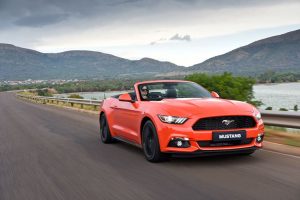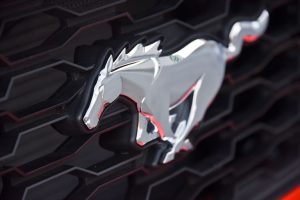
If one could condense the spirit of America into a single song, that song would probably be Steppenwolf’s “Born to be wild”. It’s loud, unapologetically brash, not everybody’s cup of tea, but yet distinctive and strangely likeable. In much the same way, the Ford Mustang has always been the epitome of an American muscle car. It’s usually been good looking in a menacing sort of way, conservative in its execution, and not really suitable for the timid or those with more subtle tastes. And yet, for all their flaws, we couldn’t help but like these Detroit beasts, such is the power of popular culture. Thanks to a myriad of movies and TV programs, the Mustang has come to represent everything we like about the USA, because all the cool kids drove them.
However, even with their wholesome, all-American appeal, Mustangs from the past never really cut the mustard as world-class sports cars. They were much too crudely engineered for that, with live rear axles and heavy engines, and their styling was often from the hit-and-miss school of thought. And so the Mustangs stayed corralled in North America, where they proceeded to build a fearsome reputation on the drag strip and offered some style and relatively affordable performance to those who loved their image and simple, down-to-earth personality.

Fortunately, thanks to Ford’s recent commitment to create global product ranges, the Mustang has been let loose in the rest of the world as well, and to get it up to the pace of its new international competition, some serious technical refinements have been applied. For starters, that live rear axle is finally consigned to the history books, replaced by a sophisticated independent rear suspension which promises greatly improved road manners and a smoother ride at the same time. The engine range is updated through the addition of a downsized, direct injected and turbocharged four-pot, and the electronic bits are equally contemporary, with various mode selections and pre-programmed trickery in their arsenal (more about that later).

It’s all great in theory, then. The latest Mustang seems capable of tackling the Europeans in their own back yard – something which is confirmed by the anomalous success of the Mustang in Germany, where it has recently become the best-selling sports car in that highly competitive (and very discerning) market. But how much of that unique Mustang character had to be sacrificed on the altar of refinement and sophistication in this quest for global appeal? Let’s find out.

The scarlet menace
Our test car certainly looked the part, with its gaping nostrils and swollen rear haunches enhanced by its black convertible roof and vivid (non-metallic) red paintwork. We were indeed very fortunate to sample the Mustang in perhaps its most eye-catching configuration, a fact borne out by the ludicrous amount of attention it garnered wherever we went. The combination of arresting styling and a blue-collar badge means that just about everybody adores this steed. Nice styling details abound, ranging from the retro-style tail lights to the shining Mustang emblem in the front grille; with a little bit of kitsch thrown in for good measure, such as the side mirror-mounted puddle lamps which project a Mustang emblem next to the car.
Sun seeker above all else
Of course, lopping the roof off the Mustang does result in some downsides. The luggage compartment is rather compromised by the folding roof’s intruding recess, and with the roof up, rearwards visibility is severely limited (though standard rear parking sensors and a camera does alleviate this issue). More significantly, the absence of a solid roof results in reduced body rigidity, an effect felt most acutely by the driver in some odd shimmies through the steering wheel over road imperfections, and a rear view mirror which vibrates at speed.
The loss in rigidity also makes itself known when the road gets twisty, where the somewhat sportily-tuned suspension feels slightly at odds with the less-than-solid body. It doesn’t handle poorly, mind you (there’s plenty of grip in corners and it changes direction with an almost European eagerness), but keen drivers will definitely find themselves more at home in a coupé, where the overhead metal gives a stiffer structure to tie the Mustang’s front- and rear ends together much more securely.

Boosted image and character deficiency
Given the dynamic compromises created by the convertible body, it’s perhaps not such a bad thing that our test car also came with the less-desirable drivetrain option. That long bonnet concealed a 2.3-litre turbo four, bolted to a 6-speed torque converter automatic gearbox. It’s plenty quick in its own right (0-100 km/h in 5.8 seconds and a top speed of 239 km/h), if nowhere near as powerful as the range-topping 5.0-litre V8 engined derivatives, and offers a lusty stream of torque across the rev range. The same EcoBoost engine also powers the Focus RS hyper-hatch, where it produces a little bit more power than the 233 kW and 430 Nm on offer in the Mustang, but it somehow feels more at home in the smaller hatchback than it does in the big American. The real issue here isn’t the performance, but the sound.

See, a lot of the Mustang’s traditional allure can be attributed to the rumbling V8 engines with which they are most commonly associated. Slotting a four-pot, no matter how good, into the space really meant for a V8 is a decision which will inevitably lead to some loss of character. This was amply demonstrated whenever adoring onlookers asked me to “rev it, please”, in which case I reluctantly obliged, only to treat them to a soundtrack with all the viciousness of souped-up leaf blower. “Whirr” went the engine, “whoosh” went the exhaust, “psssh” went the turbo’s plumbing (very softly), but nowhere was any sign of the muscled Mustang’s promised menace to be heard. It was no different behind the wheel either, where the aural signature alternated between near silence and a muted, flat drone. In a car which looks this good, some growling, snarling noises would have been most welcome.
It goes well, though
Emotional appeal aside, the 2.3-litre Ecoboost engine did its job perfectly well, and cooperated nicely with the autobox to get the hefty (a smidge over 1700 kg) convertible moving smartly off the line. It never felt out of breath, and offered plenty of overtaking- and highway performance as well. The gearbox worked best when left to its own devices, when it slipped seamlessly through the ratios in the best American tradition and made very effective use of the engine’s fat wedge of mid-range torque. Attempting to change its behaviour with the shift paddles often resulted in no noticeable performance improvements, and gave the drivetrain a slightly disjointed feel at that.
In addition, the Mustang features a novel “smoky burnout” function, which couldn’t be easier to activate: turn the stability control off, press the brake pedal firmly, and stand on the throttle. The result is an impressive display of tyre-destroying prowess, as the computer locks the front brakes, releases the rear ones, and pours all the torque into the rear tyres. It’s an impressive display of converting rubber and premium unleaded into smoke and noise with startling ease. This function is obviously intended for use only at the drag strip, but it does show that Ford’s engineers really know how to imbue their halo cars with a sense of mischief.

Space (in)efficiency
Perhaps the most obvious display of the Mustang’s American roots can be found in its packaging: it’s hard to imagine that a car could cast such a big shadow, yet offer so little cabin room. Leg-, head- and elbow room are just fine for front seat occupants, but those relegated to the rear buckets will be considerably less content. In fact, with the driver’s seat (electrically) adjusted to fit a normal-sized adult, rear legroom would be acceptable only to amputee midgets. Best to keep this in mind if you consider an al fresco jaunt down the coastline with some friends.
Showing off isn’t even that expensive
It took most of my week with the soft-top Mustang to fully understand it. The enthusiastic driver inside me was a little disappointed at its lack of real driving thrills, thanks to the convertible body style, and the uninspiring engine sound left me feeling somewhat short changed in the charisma department. There’s no doubt that there’s a genuinely great driver’s car hidden inside the Mustang platform, as demonstrated by the odd glimpses of dynamic excellence I gleaned through some of my favourite corners, but it’s stifled by weight and that twisty body.

But to dismiss the Mustang 2.3T convertible just because it could be a sharper drive would be grossly unfair. Cars such as these aren’t meant to stun the driver with their ground-covering ability and cornering prowess – if that’s what you want, just get a hardtop with a V8. Instead, the drop-top Mustang is a car to be seen in, and to strike up conversations with attractive ladies (or gents) at the car wash. If that kind of thing is important to you, and if you can afford the asking price of R 795 900, there are few cars better suited to the job – it even represents that traditional Mustang virtue of relative affordability.
Not quite as untamed as the full-fat versions, the drop-top ‘Stang is still “Born to be wild”, if the classic song were to be re-imagined by Katy Perry or perhaps Adèle. The essence is still there, but its impact has been softened. Malibu Barbie would approve.
Ford Mustang 2.3T Convertible Auto Specs
Engine :2261 cc straight-four, turbocharged
Gearbox :6-speed torque converter auto, rear wheel drive
Output :233 kW @ 5500 r/min, 430 Nm @ 2500 – 4500 r/min
Performance :0-100 km/h in 5.8 seconds, max speed 239 km/h
Consumption (official) :9.8 ℓ/100 km
Luggage compartment :322 litres
Price :R 795 900

